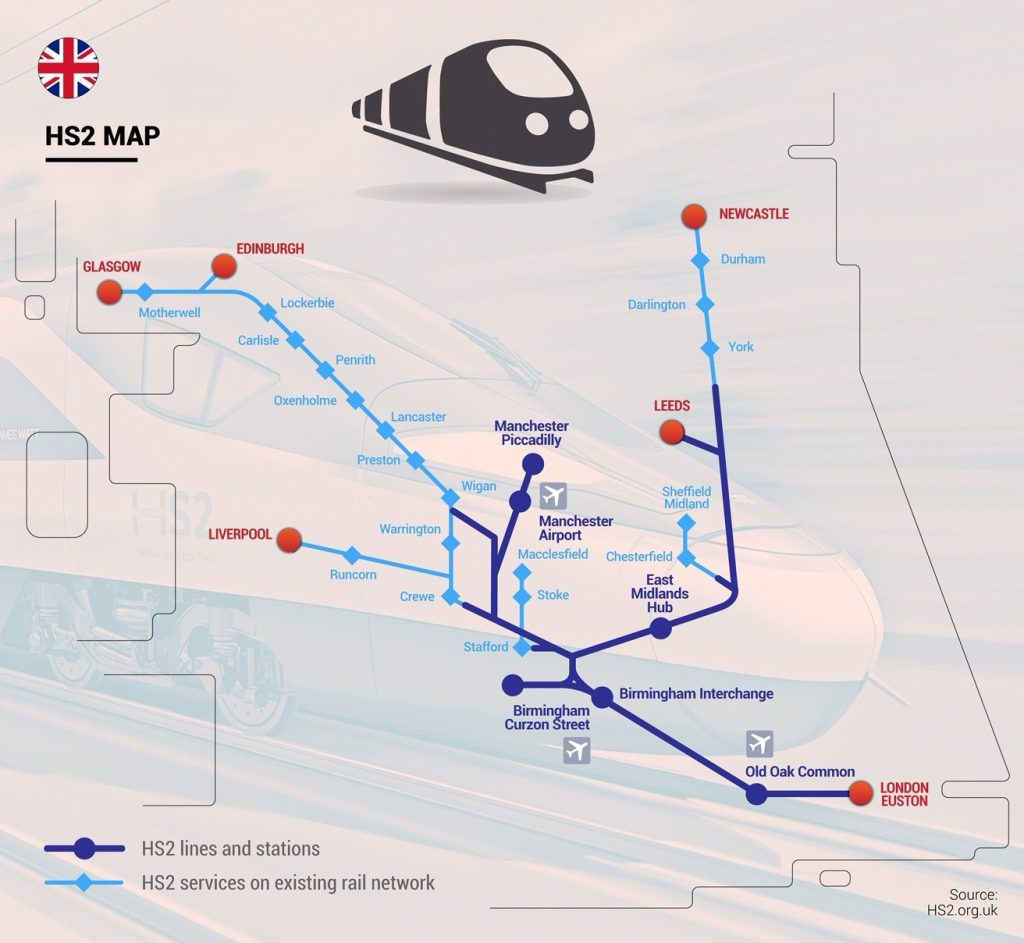
Imagine a high-speed train that could connect central London, Birmingham, Manchester and Leeds with 555 kilometres (344 miles) of track; a sustainable transport system that, when fully operational by 2033, will be able to carry 300,000 passengers a day, and more than 100 million a year.
This is the British government’s dream with High Speed 2 (HS2), one of the most ambitious high-speed rail projects in the world. The idea is to reduce travel times between some of the country’s most important cities and promote the creation of an industrial and economic hub similar to China’s success with the Pearl River Delta.
This ambitious and complex project is forecast to cost £106 billion ($137 billion) on the hopes that it will provide a series of benefits for citizens, according to the government’s website.
The impact of the new british high-speed rail
«HS2 is more than just a train». That is how the British government presents the project that it hopes will ignite the country’s most important economic regeneration in decades. In addition to promoting geographical unification, the project will create jobs and develop the areas connected by the new train service. Its economic plan forecasts 500,000 new jobs and the construction of 90,000 new houses. To date, 9,000 direct jobs have been created at the first 250 construction sites that have been opened, located mainly between London and Birmingham, according to the government’s website. Parliament has approved the construction of Phase One, which mainly concerns London. Phase Two will extend the network from Birmingham to Leeds and Manchester. It is still in the planning and environmental impact analysis stage.
HS2 rail link: making the country smaller
One of the most main goals of the new high-speed rail network is to bring Great Britain’s main cities closer together, promoting trade and economic development. This will be achieved with the construction of 25 stops from Scotland to the southeast of the island, connecting eight of the 10 largest cities.
The project spearheads the Northern Powerhouse Rail and the Midlands Rail Hub plans designed to maintain and modernise the existing rail network linking the main cities in the Midlands and the north of Great Britain. The government is investing £40 billion in maintaining the existing network. But this ageing network is unable to meet on its own the mobility needs that have emerged in recent years. So HS2 is seen as key to the viability of the rail network upgrade as a whole.

Sustainable mobility to fight congestion
The HS2 high-speed train will modernise the transport network, while reducing rail traffic on existing and heavily congested areas. The West Coast Main Line, for example, is now one of the busiest freight rail routes in Europe, along which intercity, regional trains and freight trains all run. Along this route alone, the new high-speed line will provide 13,000 seats at peak times, says HS2. The same will happen along the East Coast Main Line, which crosses the cities of York, Leeds and London, and along the Midland Main Line, between Sheffield and the capital.
Most major cities will benefit from this new infrastructure, seeing congestion on their crowded rail networks significantly reduced. Manchester, for example, has seen a 26% increase in rail traffic since 2011.
Traffic will be reduced by the new network’s capillarity as well as the number of trains that will be running on its rails. According to the government, up to 18 trains will leave London every hour and head north, each capable of carrying more than 1,000 passengers.
This will also have an impact on the environment, significantly reducing carbon dioxide emissions. The new high-speed train is the most sustainable transport system in existence, seven times less polluting than cars and 17 times less polluting than air transport. As the HS2 website says: «In 2030 you could travel 500 miles (800 kilometres) on HS2 for the same amount of carbon it takes to travel around 70 miles (112 kilometres) by car and just 29 miles (846 kilometres) by plane».

